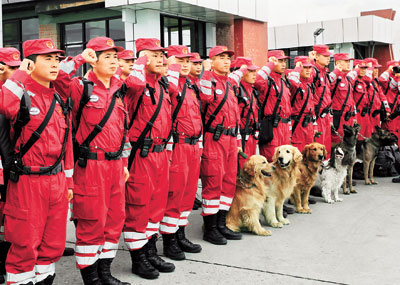|

INTERNATIONAL aid groups and governments intensified efforts to get rescuers and supplies into earthquake-hit Nepal yesterday, but severed communications and landslides in the Himalayan nation posed formidable challenges to the relief effort.
As the death toll surpassed 2,200, many countries sent emergency crews to reinforce those scrambling to find survivors in the devastated capital Kathmandu and in rural areas cut off by blocked roads and patchy phone networks. With search and rescue efforts far from over, it was unclear how much the death toll would rise.
The 8.1-magnitude earthquake centered outside Kathmandu, the capital, was the worst to hit the South Asian nation in over 80 years. It destroyed swaths of the oldest neighborhoods of Kathmandu and was strong enough to be felt all across parts of India, Bangladesh, China’s region of Tibet and Pakistan. The quake, which was followed by at least 14 aftershocks, left tens and hundreds of people injured and caused damage to properties worth over billions of U.S. dollars.
Aid organizations relayed their fears that stocks of essential supplies were rapidly running out and described the fearsome effects of the quake. A lack of electricity was complicated by a scarcity of water, with medical supplies also dwindling.
Survivors also slept in the open in Kathmandu overnight, braving the cold for fear of being crushed by the teetering ruins of buildings.
Among the destroyed buildings in Kathmandu was the nine-story Dharahara Tower, a Kathmandu landmark built by Nepal’s royal rulers as a watchtower in the 1800s and a UNESCO-recognized historical monument. It was reduced to rubble and there were reports of people trapped underneath.
Snowfalls on Saturday thwarted efforts to airlift survivors from an avalanche that hit part of a Mount Qomolangma base camp, killing at least 18 people.
A 62-member Chinese search and rescue team with sniffer dogs arrived in Kathmandu yesterday. A medical team will be mobilized and work started on an emergency aid plan, Xinhua News Agency reported. Eighteen people were killed by the earthquake in China’s Tibet.
Four Chinese nationals, including two workers with a Chinese company, a mountain climber and a tourist, were killed and five others seriously injured in Nepal, the Chinese Embassy confirmed. China has also sent planes to bring 683 stranded Chinese tourists back home.
A U.S. disaster response team was en route and an initial US$1 million in aid to address immediate needs had been authorized
Australia and New Zealand pledged more than US$4.5 million, and said they were working to locate hundreds of their citizens believed to be in Nepal. South Korea promised US$1 million in aid.
India dispatched two military transport planes as it emerged that at least 61 people had died there from the effects of the quake. There were similar offers from Sri Lanka, Pakistan, Singapore, Japan, France, Germany, Britain, Spain and Norway.
The quake will likely put a huge strain on the resources of this impoverished country best known for Mount Qomolangma, also known as Mount Everest. The economy of Nepal, a nation of 27.8 million people, relies heavily on tourism, principally trekking and Himalayan mountain climbing.(SD-Xinhua)
(More on P3, 5)
|

